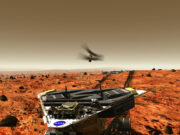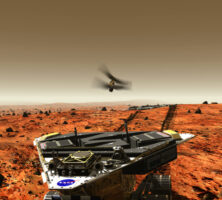One of the most unusual transportation systems ever envisioned may be the Entomopter, a robotic “artificial insect” that would fly and navigate using two sets of flapping wings powered by a chemically fueled artificial muscle. Under development at the Georgia Institute of Technology, the Entomopter—its name arising from the Greek entomon, “insect,” and pteron, “wing”—grew out of a competition to develop palm-sized “microflyers” for such military applications as the exploration of caves, bunkers, and other structures. Building on five years of study and support from agencies including the Defense Advanced Research Projects Agency, the concept has since been adapted to a more unusual mission: exploring the planet Mars.

Robotic landers, rovers, and orbiting spacecraft have provided intriguing details about certain portions of Mars. Scientists hope to explore more of our neighboring planet using low-altitude flying vehicles, but the thin atmosphere and lack of oxygen on Mars severely limits the capabilities of conventional helicopters and fixed-wing aircraft. Even to stay airborne in the thin atmosphere, for example, fixed-wing vehicles would have to fly at speeds of more than 250 miles per hour—too fast to land on the rocky terrain for refueling or gathering samples.
Researchers at the Georgia Tech Research Institute, Georgia Tech’s applied research organization, believe the Entomopter could be ideal for flying on Mars. Its flapping wings would produce enough lift to allow it to take off, fly slowly enough to observe the terrain at an altitude of 100 feet or less, and then land again on a mobile rover for refueling and downloading data. A pair of Entomopters could cross canyons, boulders, and other features that would stop surface-based vehicles. Equipped with video cameras and sensors, the Entomopters could range across the Mars surface, covering far more territory than a wheeled rover could.
So far the Mars Entomopter is only a concept, studied with support from NASA’s Institute for Advanced Concepts, based in Atlanta. The Entomopter won’t be a reality until at least 2010. Researchers have already developed some of the air vehicle’s basic systems, including the chemical muscle and a simple altimeter, but much work remains to be done before these giant insects take on the harsh Martian environment.
For example, researchers must develop a complete sensing and control system that would allow the Entomopters to detect areas of interest, navigate to them, and gather information or samples without assistance from a human. Researchers must also design systems for changing the direction of flight, most likely relying on venting exhaust from the chemical muscle along the wings. Materials will have to be chosen carefully to survive the dramatic temperature swings that take place in the Mars atmosphere.






